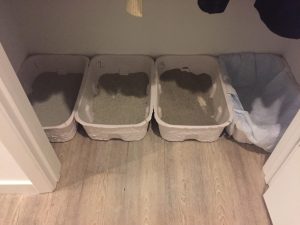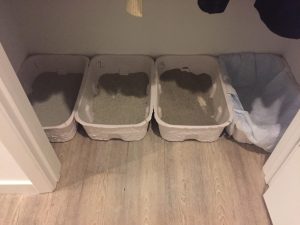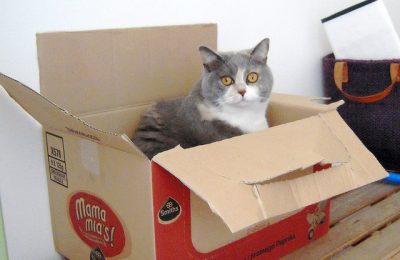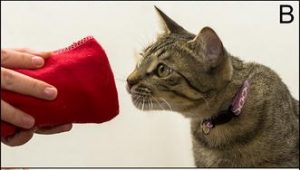Dr. Karen Overall once stated quite eloquently: “Behavior kills more cats annually than does viral disease.” One of the least tolerated behavior problems in cats is when they eliminate outside the litter box, and many cats lose their homes (and lives) for an issue that I believe is often one that COULD BE fixed, if humans:
- Understood what cats generally prefer about litter boxes
- Maintained a suitable litter box environment for their cat(s)
 Previous research has suggested cats generally prefer large boxes and clay clumping litters. It is interesting to note that when I have clients whose cats are avoiding the litter box, I often have them present their cat with a “cafeteria” of litter choices to see if their cat has a clear preference. Even when those buffets include ONLY unscented clay clumping litters of different brands, it’s easy to see that not all clumping litters are created equally…and that many cats have specific individual preferences.
Previous research has suggested cats generally prefer large boxes and clay clumping litters. It is interesting to note that when I have clients whose cats are avoiding the litter box, I often have them present their cat with a “cafeteria” of litter choices to see if their cat has a clear preference. Even when those buffets include ONLY unscented clay clumping litters of different brands, it’s easy to see that not all clumping litters are created equally…and that many cats have specific individual preferences.

But back to general preferences of cats. One thing that often surprises me when I go to a client’s home is how dirty their litter box is. It’s not unusual for folks to clean a box every other day or even less – even in homes with multiple cats and just one litter box. I personally find it gross, and I assume that cats would too. But do we REALLY know if a dirty litter box bothers cats?
Well a new study has cracked another cat code. “Does Previous Use Affect Litter Box Appeal in Multi-Cat Households?” published in the journal Behavioral Processes, sought to explore what factors related to box cleanliness might impact preferences in cats, and which ones might not matter so much.
Using group-housed cats in the Purina colony, researchers looked at several questions by offering cats a choice of two litter boxes over the course of four days, and determining their preference by whether urine and feces had been deposited in either box.
Experiment 1 offered cats the choice between a clean box, and a box which had urine and feces of a familiar cat in it. Output determined that cats preferred the clean box over the used one.
Experiment 2 presented a choice between a clean box and a box that had been treated by adding only the odor of either (1) another cat’s urine, (2) another cat’s feces or (3) the odor of both. Cats used both the clean box and the “stinky” boxes equally.

Experiment 3 looked to verify that it was the physical obstructions caused by urine clumps and poops in the box, and not the odor, that was driving the cats’ preferences. To do this, experimenters created odorless fake urine clumps with saline, and odorless fake poop out of gelatin placed in silicone molds (do they make poop shaped silicone molds?!?!?). They also manipulated the amount of “obstructions” in the box: 1 clump vs 3 clump and 1 log vs 3 logs – to mimic the possible amount of material that might be in a box if a cat lives alone or with multiple other cats.
Cats preferred the clean box overall, unless there was just one gelatin poo in the box, in which case they showed no strong preference. When given the additional choice, between a box with one fake urine clump and a box with one gelatin poo, the cats also preferred the box with the fake poo. When there were MORE obstructions, the cats in the study showed a stronger preference for the clean box.
So what does this study tell us? A box free of obstruction is more important to cats than a box that is completely free of urine or fecal odor. You don’t necessarily need to sanitize your box if you are scooping it daily.
It also suggests what most of us already believed – that cats don’t really mind sharing a box with other cats as long as it’s cleaned regularly. We should note that the cats in this study all lived in groups and got along with the other cats in these groups, so it’s possible that cats who don’t get along might be less open to sharing (although we have no evidence at this time to say that, so someone should get on that study!).
Clumps and logs in the litter may make it harder for cats to find a clean spot to dig in, or might be unpleasant to step on. A bigger box, or more boxes would help with both of these issues, but there’s no way around it:



